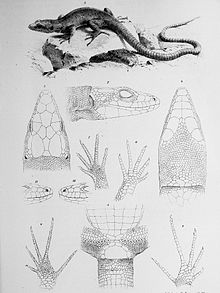Dinarolacerta
| Dinarolacerta | ||||||||||||
|---|---|---|---|---|---|---|---|---|---|---|---|---|

Moso lizard ( Dinarolacerta mosorensis ) |
||||||||||||
| Systematics | ||||||||||||
|
||||||||||||
| Scientific name | ||||||||||||
| Dinarolacerta | ||||||||||||
| Arnold , Arribas & Carranza , 2007 |
Dinarolacerta is a genus of real lizards that occurs in two species in southern Croatia (north to Split ), in southern Bosnia and Herzegovina , in Montenegro and in the far north of Albania .
features
Dinarolacerta species are small lizards with a head-to-trunk length of around 7 cm, and their heads and bodies are clearly flattened. The sex dimorphism in terms of size is only slight in this genus of lizards. Nine teeth sit on the premaxillary , wing bones are missing.
They are generally brownish in color, with flanks darker than the back, and often darker spots and spots, on the back, as a band along the midline of the back, or on the sides of the body.
The ventral side is yellowish to orange, with a row of blue spots on the outermost row of ventral scales. The throat is the same color as the belly and often has dark spots on it. The bruises on the shoulder region found in many lizards are missing. Young animals have the same body color as the adults, but often have bright green or blue colored tails.
Way of life
The two Dinarolacerta species live in the mountains in rocky regions with frequent rainfall and are more found in shady biotopes than the Dalmatian pointed-headed lizard ( Dalmatolacerta oxycephala ).
During mating, the male bites into the flank of the female. A clutch usually comprises four, rarely up to eight eggs. The embryos in freshly laid eggs are well developed and hatch after 17 to 20 days, whereas most smaller lizard species need 40 or more days to do so.
Taxonomy
The genus was first transferred from the Lacerta genus to a new genus called Archaeolacerta by R. Mertens in 1921, together with other European mountain lizards . The characteristics of the so-called “Arcaolacerten” - especially the flattened body and head - were interpreted as ecomorphological adaptations to mountain and rock habitats. However, the genus was separated due to molecular genetic features.
In 2009 Pavlicev and Mayer reported that the genus Dinarolacerta is closely related to the quill lizards ( Algyroides ) due to the genes examined . A further support for this finding was provided by Podnar et al. a. (2014). Surprisingly, the keel lizards turned out to be paraphyletic , as the genus Dinarolacerta branches off in the phylogenetic tree within the keel lizards. However, the relationship has not yet been conclusively clarified.
If the paraphyletic grouping of the keel lizards with the genus Dinarolacerta were to continue to be confirmed, Dinarolacerta species would have to be re-classified in Algyroides . A western ( Algyroides fitzingeri + A. marchii ) and an eastern ( A. moreoticus + A. nigropunctatus ) genetic group can be seen in the keel lizards , which coincide with the distribution areas of the four species. Accordingly, the species of the genus Dinarolacerta are also more closely related to the eastern group of the quill lizards than the western quill lizards are related to the eastern quill lizards.
In general, the relict populations in the Dinarolacerta area were found to be genetically heterogeneous. The individual populations in the strongly dissected area are represented by eight very clearly pronounced haplotypes , which do not form any distinctive clades among one another. These populations show a similar or stronger variety of the examined genes than is the case with other Mediterranean lizards, which vary greatly in their characteristics, e.g. B. the Adriatic wall lizard ( Podarcis melisellensis ), which is distributed over numerous islands in twenty subspecies . According to Arnold u. a. for the number of species within the genus Dinarolacerta still result in a change.
species
- Montenegro pointed lizard ( Dinarolacerta montenegrina Ljubisavljevi, Arribas, Duki & Carranza, 2007)
- Moso lizard ( Dinarolacerta mosorensis (Kolombatovic, 1886))
literature
- E. Nicholas Arnold, Oscar Arribas, Salvador Carranza: Systematics of the Palaearctic and Oriental lizard tribe Lacertini (Squamata: Lacertidae: Lacertinae), with descriptions of eight new genera (= Zootaxa . 1430). Magnolia Press, Auckland 2007, ISBN 978-1-86977-097-6 . (Digitized version, PDF; 2.76 MB) .
- Katarina Ljubisavljević, Oscar J. Arribas, Georg Dzukic, Salvador Carranza: Genetic and morphological differentiation of Mosor rock lizards, Dinarolacerta mosorensis (Kolombatovic, 1886), with the description of a new species from the Prokletije Mountain Massif (Montenegro) (Squamata: Lacertidae ). (Abstract PDF)
- HAJ Bosch: Waarnemingen aan de Mosor-berghagedis (Lacerta mosorensis). Observations on Lacerta Mosorensis. In: Lacerta. No. 47-4, 1989, pp. 108-111. (PDF)
Web links
- Dinarolacerta in The Reptile Database
- Research, protection and promotion of the endemic Balkan rock lizards ( Dinarolacerta ssp.) In Montenegro, project page by Katarina Ljubisavljević (English)
- Project page for the protection of the mosquito lizard and Dinarolacerta montenegrina in Montenegro (Serbian)
Individual evidence
- ^ RA Pyron, FT Burbrink, JJ Wiens: A phylogeny and revised classification of Squamata, including 4161 species of lizards and snakes. In: BMC Evol. Biol. 13, 2013, p. 93. doi : 10.1186 / 1471-2148-13-93 here p. 17.
- ^ M. Pavlicev, W. Mayer: Fast radiation of the subfamily Lacertinae (Reptilia: Lacertidae): history or methodical artefact? In: Mol Phylogenet Evol. 52 (3), Sep 2009, pp. 727-734.
- ↑ Martina Podnar, Branka Bruvo Madaric, Werner Mayer: Non-concordant phlogeographical Patterns of three widely codistributed endemic Western Balkans lacertid lizards (peptilia, Lacertidae) shaped by specific Habitat requirements and different Responses to Pleistocene climatic oscillations. In: Journal of Zoological and Systematic Evolution Research. 52 (2), 2014, pp. 119–129.
- ^ E. Nicholas Arnold, Oscar Arribas, Salvador Carranza: Systematics of the Palaearctic and Oriental lizard tribe Lacertini (Squamata: Lacertidae: Lacertinae), with descriptions of eight new genera (= Zootaxa. 1430). Magnolia Press, Auckland 2007, ISBN 978-1-86977-097-6 , p. 43.
- ↑ Prokletije pointed-headed lizard
- ^ Prokletije Rock Lizard
